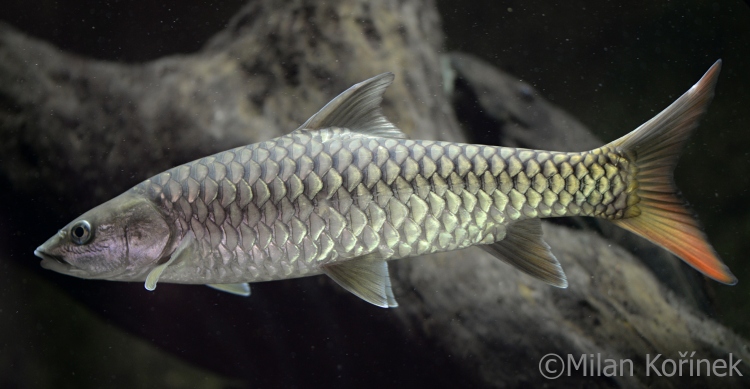Prof. Prabha Shankar Shukla
The Golden Mahseer, sometimes called the Himalayan Mahseer or Tor putitora, is a popular sport fish found in the lower Teesta and Rangeet river basin. The Golden Mahseer, portrayed in the narratives of Jim Corbett and Rudyard Kipling, is regarded as a “prize catch” for fishermen and a “fierce combatant.”
The Teesta and Rangeet rivers are home to two of the sixteen known types of Mahseer found in Indian river waters: the Himalayan Golden Mahseer and the Copper Mahseer. But few people know that the golden mahseer is an endangered species that ought to be protected and not caught.
The Himalayan or Golden mahseer (Tor putitora), once dubbed the “tiger of the river,” is endangered because of harmful fishing practices, irresponsible brooder fishing, and habitat fragmentation brought on by dam and barrage building. The IUCN presently classifies the species as “Endangered.”
Since catch limits are not strictly enforced and mesh sizes are not regulated, the current regulatory system has not helped to conserve it. Fisheries is no longer a minor aspect of agriculture. It has established its relevance in India and around the world by growing its contribution to the national economy.
Fish production has increased from 0.75 million tonnes in 1951 to more than 8.3 million tonnes now. In India, the number of people who make a living from fishing has risen to over 14 million. The marine sector alone employs more than four million people, dispersed throughout 3,827 fishing villages along the beaches. When it comes to foreign cash generated by fishing, India’s export of fish goods exceeds Rs.30,421 crores, ranking second only to rice.
As it relates to Meghalaya, the fishing industry is unquestionably vital to the state’s overall economic growth. Despite having abundant inland fishing resources, Meghalaya is not fully utilizing them, which offers a huge opportunity for the fisheries industry to grow. Even though the state is primarily a fish-consuming state, it imports fish from states like Assam and Andhra Pradesh since the state’s fish supply cannot keep up with the state’s rising demand.
The Government of Meghalaya has identified fisheries as a key sector and has launched the Meghalaya State Aquaculture Mission (MSAM). Therefore, it is imperative that we identify and promote aquaculture as an alternative means of increasing fish production in the state of Meghalaya. But the question is, how prepared are we to take up this challenge?
This certainly is a huge task, but if we all offer our participation sincerely for this noble cause, there is nothing that cannot be achieved. Golden Mahsheer holds significant economic, recreational, and cultural value in the rivers and lakes across eleven Asian nations, as per the Food and Agriculture Organization (FAO).
As its name suggests, Mahseer is a combination of two words: mahi – fish and sher – tiger, and hence is also referred as tiger among fishes. Despite its past abundance in the waters of Meghalaya, the Golden Mahseer population has drastically reduced in recent years, calling for urgent conservation measures. It’s need of the hour for community participation in mahseer conservation and safeguarding the fish breeding grounds should be a crucial step towards reviving its population. Therefore, relevant practical skills, entrepreneurial aptitude, self-employment, leadership qualities and confidence among graduates, and attracting and retaining youth in agriculture and fish farming will all be promoted through NEP 2020 course curricula. Like in other areas, skill enhancement for running hatcheries and other aquaculture units has to be imparted to young students. They have to be trained as professionals in agri-business management.
Being Vocal for Local, region-specific courses such as Hill Agriculture & Pisciculture, Tribal Agriculture, etc. should be promoted in the region. Recently new degree programmes and vocational courses have been recommended in emerging fields like genomics (biotechnology), nanotechnology, GIS, precision farming, conservation agriculture, secondary agriculture, hi- tech cultivation, specialty agriculture, renewable energy, artificial intelligence, big data analytics, dryland horticulture, agro-meteorology and climate change, community science, and food nutrition & dietetics. These will need additional high-quality human resources and a shift in pedagogy which will help our tribal students to come up with new innovative start-ups not only in Meghalaya but in the entire north east.
In the hill regions, fish represents an essential, source of high quality and inexpensive animal protein, crucial for the balanced diet of the marginally food secure communities. Keeping in view the global, national and ecological changes, enhancing fish production in hills through intervention measures such as research, technological support, awareness programmes and frontline demonstration activities is a must. There is a need to document aquatic biodiversity in hill states and generate research information that helps in developing ecologically sustainable strategies for fish yield enhancement.
Students will definitely play a crucial role in expansion of aquaculture in partnership mode involving public and private enterprises, taking up challenges in establishing new start-ups towards development of farmer friendly android applications; telephonic help lines and online technical consultancy platforms for this great cause towards promoting and sustaining fish biodiversity in the region.
In 2012, under the Meghalaya State Aquaculture Mission (of the fisheries department), this concept of conserving our declining fish population endemic to the region was therefore encouraged across the state. In the Garo Hills, the fish sanctuary on the Chibok River was created in 2015. With a focus on the chocolate and golden mahseer, the goal was to conserve rare fish species in these reserves. According to the IUCN Red List, the golden mahseer, known as Ka.chol, is endangered, whereas the chocolate mahseer, or Neolissochilus hexagonolepis, or Na.rong in the local language, is considered near threatened.
The forefathers of the tribal community lived in harmony with nature. They practiced community fishing with various gears; they also utilized plants such as Maka.Naru and Rutel to ‘poison’ the fishes, which was actually an attempt to stun them so they could be captured. The fish would resuscitate in one and a half hours, and it did not kill them completely. However, overfishing and overexploitation of natural resources have major consequences, and when the community was made aware of this, they consented to the idea of establishing a sanctuary to safeguard the fish. In carrying out its job, the community is exceedingly watchful and keeps an eye out for anyone who might try to violate the law. Defaulters face a steep charge of Rs 30,000; in certain other regions, the fine could also include a cow, pig, bag of rice, packages of biscuits, and sugar.
The Golden Mahseer population in Meghalaya’s rivers and lakes was formerly abundant, but in recent years, it has significantly declined, necessitating immediate conservation action. At NEHU, our mission is to evaluate and prioritize important habitats for conservation and restoration. In order to forecast likely future changes, we will assess its population dynamics and structure and compare the data already available with records from the decade before it. As villagers, students, legislators, and fishing clubs, we will include local stakeholders in various capacities in order to accomplish population restoration in the near future.
Reducing indiscriminate fishing and promoting broodstock conservation will be aided by awareness campaigns and the construction of banners to teach those nearby about the species’ nesting habits and migration patterns. The ICAR-Directorate of Coldwater Fisheries Research (ICAR-DCFR), Bhimtal, jointly with Department of Zoology, NEHU, Shillong have successfully conducted a seed ranching program for the iconic Golden Mahseer at NEHU lake here recently. The dignitaries emphasized the critical need for community participation in mahseer conservation and called for safeguarding the fish breeding grounds as a crucial step toward reviving its population. ICAR-DCFR, Bhimtal and Department of Zoology and Biodiversity Informatics Centre at NEHU is committed to conserving the Golden Mahseer in the natural ecosystems of Meghalaya. This joint initiative will bolster the golden mahseer population and conserve its genetic diversity. As part of the event, hatchery reared fingerlings of Golden Mahseer were released into the lake.
Over 200 participants actively took part in the program, marking a significant step toward the conservation of this vital species. The programme of ranching golden mahseer in Meghalaya, an important sport fish, was conceived by Dr. Pramod Kumar Pandey, Director, ICAR- Directorate of Coldwater Fisheries Research, Bhimtal. This integrated effort will help in achieving long term conservation goal of the ‘Charismatic’ golden mahseer. The Mahseer Conservation Project is a small step in the lakes of NEHU, but like they say, little drops of water make a mighty ocean. This initiative is a kick start to conserve and restore the declining population of the species in the natural waters of the region.
(The author is Vice Chancellor of North Eastern Hill University, Shillong)





